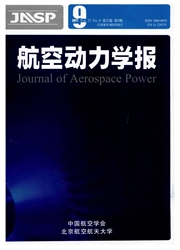

 中文摘要:
中文摘要:
针对一个中心体稳定的燃烧室通过G方程的方法推导建立了火焰面波动与声波速度波动之间的耦合关系,并进而得到了燃烧热释放模型的数学函数.推导过程中考虑了燃烧膨胀效应对火焰面运动的影响,弥补了前人研究中忽略了燃烧膨胀效应的不足.该函数表明在几何结构和燃料成分等参数保持不变的情况下,湍流燃烧速度是影响热声振荡的关键参数,能够同时强烈的影响燃烧热释放模型的振幅和相位,当量比和入口空气温度等参数是通过改变湍流燃烧速度最终影响了热声振荡现象;而只有当燃烧火焰传播速度相对较大时,密度膨胀比才会对热释放幅值产生影响,并且会对热释放的相位产生影响,从而指出了各参数影响热声振荡的具体途径和相对大小.通过将推导的燃烧热释放波动模型与模态分析方法相结合,系统连续地分析了压力振幅增长率、固有频率和声压模态等重要的热声振荡特性参数随着当量比和入口空气温度的变化关系,从而得到了热声振荡稳定区间和非稳定的区间的云图.对理解和控制热声振荡现象具有重要的实际指导意义.
 英文摘要:
英文摘要:
Coupling relationship between flame variation and acoustic velocity variation was established by G-equation method for combustor with the central body,the mathematical function of combustion heat release model was obtained.In early work,the heat release model was usually derived with the premise of ignoring the combustion expansion effect and the influence of equivalence ratio or temperature on thermo-acoustic instability was studied discretely,This model was developed invoking the combustion expansion effect,which is very different from early work.Result showed that it was the turbulent flame velocity but not the combustion expansion effect the response of heat release strongly.When turbulent flame velocity was fixed,the density expansion rate had very weak influence on the magnitude of the transfer between the heat release rate and acoustic perturbation,and no influenceon the phase at all;but when the turbulent flame velocity was changed,both of the magnitude and phase of the transfer function were strongly influenced.Then acoustic modal analysis with the heat release model was carried out to determine the natural frequencies and their corresponding growth rate.At last the influence of the equivalence ratio and inlet air temperature on combustion instability was discussed successively.The cloud chart of stable zones and instable zones were developed,which is very useful to understand and control thermoacoustic instability.
 同期刊论文项目
同期刊论文项目
 同项目期刊论文
同项目期刊论文
 期刊信息
期刊信息
